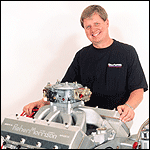 By David Reher, Reher-Morrison Racing Engines
By David Reher, Reher-Morrison Racing Engines
“Increasing cylinder bore diameter is the proverbial free lunch – and for once, it really is free.”
Is bigger always better? It depends on the circumstances. A bigger transporter, a bigger horsepower number, or a bigger budget is usually a good thing in motorsports. But a bigger mortgage, a bigger gas bill, or a bigger headache is not usually desirable.
One area where bigger is almost always better is cylinder bore diameter. Whether a racing engine is built to a maximum displacement specified by the rulebook or built to deliver maximum performance for the dollar, a big bore invariably has the advantage over a small-bore combination.
In the early days of internal combustion, most engines had an undersquare design – the bore diameter was smaller than the stroke dimension. These early powerplants were limited to relatively slow operating speeds by low quality gasoline, primitive ignition systems and unreliable mechanical components, so the advantages of a bigger bore weren’t realized. As fuel quality, ignition system technology, metallurgy, and the understanding of valvetrain dynamics improved, engineers quickly moved toward oversquare designs to take advantage of the benefits of a larger bore-to-stroke ratio. Oversquare engines are now ubiquitous in automobiles because they produce greater higher specific output than their undersquare predecessors.
Real-world examples of the performance advantages big-bore engines abound. Consider two variations on the small-block Chevrolet theme: the 302 and 305-cubic-inch Chevy V8s. In 1967-69, Chevy produced the famous 302cid small-block (4-inch bore x 3-inch stroke) to make the Camaro Z/28 eligible to compete in the Sports Car Club of America’s Trans Am road racing series, which required a 5-liter production powerplant. In 1976 Chevy introduced a 305ci small-block (3.74-inch bore x 3.48-inch stroke) to comply with the government’s fuel economy and emissions mandates. Today the race-inspired big-bore/short-stroke 302 is lionized by enthusiasts as one of Chevy’s finest first-generation small-blocks, while the small-bore/long-stroke 305 symbolizes the dreary performance of the smog-motor era. Even though the two engines had nearly identical displacements, their performance characteristics were decidedly different.
So why do big-bore engines typically outperform their small-bore brethren? There are several reasons. The first is airflow: Bigger bores improve breathing. Anyone who has tested cylinder heads on a flow bench has seen the positive effect of using a fixture with a bigger bore diameter. Increasing the bore diameter almost always enhances airflow by unshrouding the valves. Moving the cylinder wall away from the valve heads typically produces a big gain in cylinder head efficiency.
The second reason is that increasing bore diameter adds cubic inches without a penalty in additional windage or internal friction. It’s the proverbial free lunch – and for once, it really is free. Lengthening the crankshaft stroke to increase displacement has two undesirable consequences: increased friction (due to the greater distance that the rings travel on the cylinder walls) and increased windage (due to the larger arc of the rotating assembly). As long as the block has adequate cylinder wall thickness to maintain ring seal, increasing the bore diameter has no downside.
So why doesn’t every drag racer run the biggest cylinder diameter that’s feasible for his or her engine? In my conversations with racers, I’ve learned that there are some lingering misconceptions about cylinder bore sizes.
When Buddy Morrison and I started building racing engines, pistons and rings were available only in limited sizes. We had a choice of standard bore, .030-inch oversize, and .060-inch oversize. That was it. So if a racer wanted to maximize the life of an engine, the logical plan was to start with .030-inch oversize pistons. After a few overhauls, the piston-to-wall clearance would become unacceptably large, and the block would then be bored to .060-inch oversize. By this time, the cylinder walls were often alarmingly thin, and the chances of cracking a block were good.
A lot has changed for the better since then. The metallurgy of racing blocks has improved dramatically, and the wall cross-sections are much thicker than in the junkyard production blocks we used back in the day. Custom pistons and rings are now available in a virtually unlimited range of sizes. There’s no need to make jumps in bore diameter in .030-inch steps when you can order pistons and rings in .001-inch increments. My advice is to start with the biggest bore that’s feasible, and then replace the pistons and rings with incrementally larger parts during rebuilds.
Some racers believe that a small-bore engine will be easier to repair after a catastrophic failure. Experience teaches me that if you have a catastrophic engine failure in a cast-iron block, chances are that the block isn’t going to be repairable regardless of its bore size. Even a dropped valve is going to cause damage that’s unlikely to be repaired by boring the cylinders a few thousandths of an inch. At the minimum, a damaged block is probably going to need a sleeve; in the worst case, it’s going to have to be replaced.
Not everyone has the ability or the budget to race a Pro Stock, but sportsman racers can tap into Pro Stock technology. Today’s 500ci Pro Stock engines have the biggest cylinder bores that will fit in a block with 4.900-inch bore centers. Many Pro Stock racers are running 4.730-inch bores, with only .170-inch of iron between the cylinders – and some are even running bigger bores. I’ve adopted a similar approach for our big-inch sportsman engines for Top Sportsman and Top Dragster competition. Our 572ci and 622ci Super Series engines have 4.625-inch cylinder bores, which is the practical limit in a conventional big-block with 4.840-inch bore centers. If a customer wants an engine with smaller cylinder bores, I’ll be happy to build it, but I know that bigger is better when it comes to cylinder diameter.
